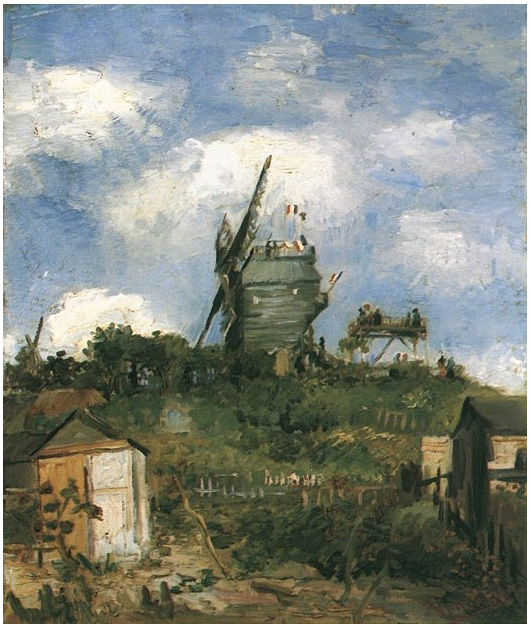One work of particular interest is his Moulin de la Galette. Before analyzing his work, however, it must be noted that the term Moulin de la Galette refers to a windmill in the Montmartre District of Paris. The windmill was built in the 17th century and is still standing today.
 | ||
| The real Moulin de la Galette, now standing as a monument. |
 |
| Moulin de la Galette, Maurice Utrillo. Watercolor. |
The work is a watercolor of the area around Moulin de la Galette; the windmill itself can be made out in the top right of the work. Utrillo made several different versions of Moulin de la Galette, using different forms of media and different angles of la Galette. One such version is shown below.
 |
| Moulin de la Galette, Maurice Utrillo. Oil on canvas. |
Throughout his career, Utrillo got to know artists like Henri Matisse and Pablo Picasso, whom he met with on a regular basis. The painting above seems to take hints from Matisse's brightly colored Expressionist style, evoking sensations of a warm suburb in the middle of spring. Nevertheless, Utrillo was not the first artist to paint scenes of Moulin de la Galette. Other artists that painted works on la Galette include Vincent van Gogh and Pierre-August Renoir.
 |
| Le Moulin de la Galette, Vincent Van Gogh, oil on canvas. 1886. |
Comparing the works of Utrillo and Van Gogh side-by-side, it is interesting to note the passage of time in terms of the landscape surrounding the windmill itself. Van Gogh's version features a rural countryside around the windmill, while Utrillo's version (painted approximately 40 years later) shows that the city of Paris has begun growing around the windmill. An illustration of the rapid changes brought about by constant urbanization and modernization of technology.
Based on what my Arts History instructor told us in class, avant-garde works that fell under movements like post-impressionism, Dada, symbolism, and Fauvism were labelled as "degenerate" by Adolf Hitler and his Nazi Socialist party and then displayed in Munich, Germany. Hitler and the Nazis felt that this so-called "degenerate" art was the result of clinically handicapped and mentally unstable people that was "contaminating" the cultural population, so to say. Entartete Kunst, as the show was called, began in 1937, was toured for four years, and was viewed by approximately 3 million people. Among these "degenerate" works was Utrillo's.
For more information on Entartete Kunst, visit:
http://fcit.usf.edu/holocaust/arts/artdegen.htm
To see more versions of Moulin de la Galette by Utrillo and Van Gogh, visit
http://www.wikipaintings.org/en/maurice-utrillo/moulin-de-la-galette-3#close (For Utrillo), and
http://www.vangoghgallery.com/catalog/Painting/295/Le-Moulin-de-la-Galette.html (For Van Gogh)
No comments:
Post a Comment